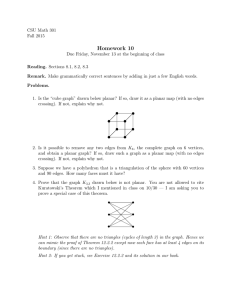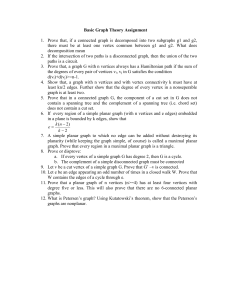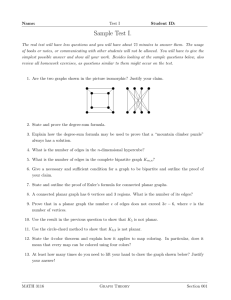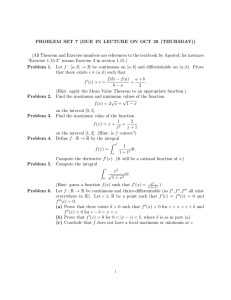Fall 2015, Math 431: Week 8 Problem Set
advertisement
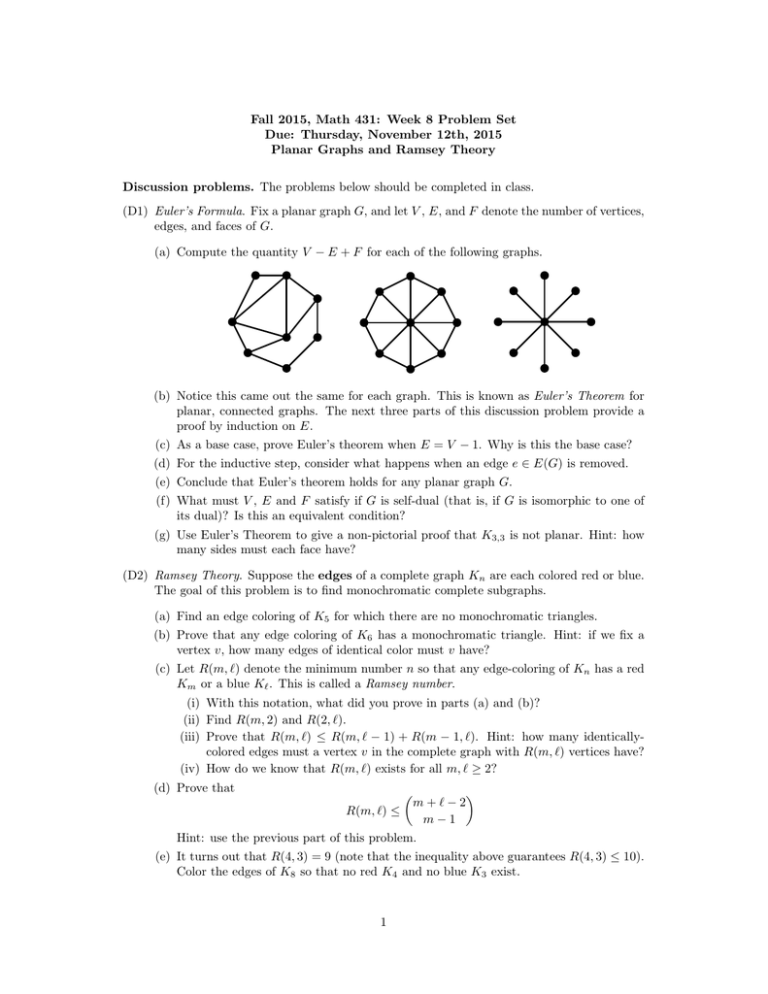
Fall 2015, Math 431: Week 8 Problem Set Due: Thursday, November 12th, 2015 Planar Graphs and Ramsey Theory Discussion problems. The problems below should be completed in class. (D1) Euler’s Formula. Fix a planar graph G, and let V , E, and F denote the number of vertices, edges, and faces of G. (a) Compute the quantity V − E + F for each of the following graphs. (b) Notice this came out the same for each graph. This is known as Euler’s Theorem for planar, connected graphs. The next three parts of this discussion problem provide a proof by induction on E. (c) As a base case, prove Euler’s theorem when E = V − 1. Why is this the base case? (d) For the inductive step, consider what happens when an edge e ∈ E(G) is removed. (e) Conclude that Euler’s theorem holds for any planar graph G. (f) What must V , E and F satisfy if G is self-dual (that is, if G is isomorphic to one of its dual)? Is this an equivalent condition? (g) Use Euler’s Theorem to give a non-pictorial proof that K3,3 is not planar. Hint: how many sides must each face have? (D2) Ramsey Theory. Suppose the edges of a complete graph Kn are each colored red or blue. The goal of this problem is to find monochromatic complete subgraphs. (a) Find an edge coloring of K5 for which there are no monochromatic triangles. (b) Prove that any edge coloring of K6 has a monochromatic triangle. Hint: if we fix a vertex v, how many edges of identical color must v have? (c) Let R(m, `) denote the minimum number n so that any edge-coloring of Kn has a red Km or a blue K` . This is called a Ramsey number. (i) With this notation, what did you prove in parts (a) and (b)? (ii) Find R(m, 2) and R(2, `). (iii) Prove that R(m, `) ≤ R(m, ` − 1) + R(m − 1, `). Hint: how many identicallycolored edges must a vertex v in the complete graph with R(m, `) vertices have? (iv) How do we know that R(m, `) exists for all m, ` ≥ 2? (d) Prove that m+`−2 R(m, `) ≤ m−1 Hint: use the previous part of this problem. (e) It turns out that R(4, 3) = 9 (note that the inequality above guarantees R(4, 3) ≤ 10). Color the edges of K8 so that no red K4 and no blue K3 exist. 1 Required problems. As the name suggests, you must submit all required problem with this homework set in order to receive full credit. (R1) Prove that the wheel graph Wn is self-dual. (R2) Prove that if any 2 edges are removed from the graph K6 , the result is not planar. Is the same true if we remove 3 edges? (R3) Prove that if we color the edges of K6 either red or blue, then there will be at least two monochromatic triangles. (R4) Let n > 1 be a positive integer. Prove that R(n + 2, 3) > 3n. Selection problems. You are required to submit one selection problem with this problem set. You may also submit additional selection problems, but the total number of points awarded (excluding challenge problems) won’t exceed the total possible score on this problem set. (S1) Fix a simple planar graph G with V vertices and E edges. (a) Prove that E ≤ 3V − 6. (b) Is it true that any connected graph satisfying this inequality is planar? (S2) There are 9 passengers on a bus. Among any 3 passengers, there are at least two who know each other. (a) Prove that there are 5 people who each know at least 4 other people. (b) Is it true that there are 5 people who all know each other? 2

